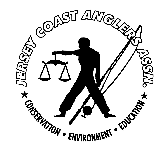 |
 |
|
|
||
 |
 |
|
|
||
American Sportfishing Association Press Release
For Release: April 1, 2004
(from Jersey Coast Anglers Association May 2004 Newsletter)
Senator Kay Bailey Hutchison (R-TX) and Senator John Breaux (D-LA) introduced the Freedom to Fish Act (S. 2244) on March 25, closely mirroring a bill introduced in the House of Representatives last year. Responding to proposals to establish a national network of coastal no-fishing zones, the American Sportfishing Association and Coastal Conservation Association crafted the draft legislation to lead the industry and sportfishing groups in advocating sensible approaches to the establishment of marine protected areas.
“Saltwater fishing is soaring in popularity, yet the sport has never been so threatened as it is right now,” said ASA President and CEO Mike Nussman. “Especially over the last several years, many different groups, including the sportfishing community, have been pushing for stronger ocean conservation policies. But better conservation does not need to come at the expense of sportfishing. The sportfishing community will be an important ally in broader efforts to make progress for our oceans.”
The House version of the Freedom to Fish Act (H.R. 2890) was introduced on July 24, 2003 by Congressman Jim Saxton (R-NJ). A handful of states also have passed or are considering similar Freedom to Fish bills. Anglers can lend their support for the Freedom to Fish Act by visiting ASA’s website, http://www.asafishing.org .
Both the current Senate and House versions of the Freedom to Fish Act: Acknowledge sportfishing’s significant constituency; the sport’s substantial social, economic, and conservation values; and anglers’ vested interest in healthy fisheries; Uphold the longstanding policy of the federal government to allow public access to public lands and waters for recreation when consistent with sound conservation; Call for criteria to guide decisions on the establishment of marine protected areas, including conservation and monitoring goals and evaluating impacts on public access; and Ensure anglers have opportunities to be involved during policy development.
The idea for marine protected areas originated as a way to address what a wide range of experts agree are the biggest threats to ocean fisheries and marine environments—commercial overharvest, excessive bycatch, and habitat destruction. “There’s no question we need better overall marine fisheries management, and that starts with sustainable fisheries,” said Nussman. Over the last several years, marine conservation policy has been increasingly in the spotlight as threats to ocean fisheries and habitat have received high profile both in government circles and the news media. The idea to protect sensitive marine areas evolved into proposals (or in some cases actual policy) to close off all public access to vast coastal areas, whether or not sound science existed to warrant these drastic measures. “Our collective progress on important ocean policy initiatives has been sidetracked by the debate over no-fishing zones,” said Nussman. “All the various groups that care about marine conservation need to work together for our shared interests. The angling constituency has a longstanding role in the development of sound marine policy. We hope the U.S. Ocean Commissions report coming out later this month will acknowledge that role and put marine protected areas in perspective as one management tool out of many conservation options.”
The American Sportfishing Association has been involved with several recent milestones in the evolution of ocean policy, including a lead role in pushing for the Sustainable Fisheries Act amendments to the Magnuson-Stevens Fishery Management and Conservation Act in 1996 and representing the U.S. sportfishing community on the International Commission for the Conservation of Atlantic Tunas, or ICCAT, the international coalition working on cooperative measures to protect billfish and other imperiled marine species.
“Restricting saltwater anglers’ access should only be considered if there’s reason to think they’re having an impact and other conservation methods like catch and release and size limits won’t go far enough,” said Nussman. “Saltwater anglers have accepted restrictions on their catch and technique and even their access on a number of occasions when fisheries were in trouble. They’ve been vocal advocates for tough management decisions to recover fisheries.”
The American Sportfishing Association is the sportfishing industry’s trade association, uniting more than 600 members of the sportfishing and boating industries with state fish and wildlife agencies, federal land and water management agencies, conservation organizations, angler advocacy groups, and outdoor journalists. The American Sportfishing Association safeguards and promotes the enduring social, economic, and conservation values of sportfishing.